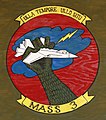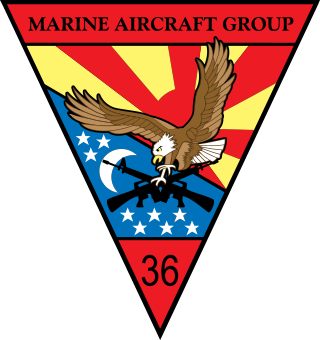
Marine Aircraft Group 36 (MAG-36) is an active air group of the United States Marine Corps, tasked with providing assault support aircraft. It is currently part of the 1st Marine Aircraft Wing, itself an integral part of the III Marine Expeditionary Force, and based at Marine Corps Air Station Futenma in Okinawa, Japan.
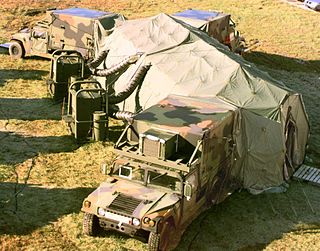
The Direct Air Support Center (DASC) is the principal United States Marine Corps aviation command and control system and the air control agency responsible for the direction of air operations directly supporting ground forces. It functions in a decentralized mode of operation, but is directly supervised by the Marine Tactical Air Command Center (TACC) or the Navy Tactical Air Control Center (NTACC). During amphibious or expeditionary operations, the DASC is normally the first Marine Air Command and Control System (MACCS) agency ashore and is usually categorized as the Ground Combat Element's (GCE's) senior Fire Support Coordination Center (FSCC). The DASC's parent unit is the Marine Air Support Squadron (MASS) of the Marine Air Control Group (MACG).

Marine Light Attack Helicopter Squadron 367 (HMLA-367) is a United States Marine Corps helicopter squadron consisting of AH-1Z Viper attack helicopters and UH-1Y Venom utility helicopters. Originally commissioned during World War II, the squadron participated in combat operations on Peleliu and Okinawa. Reactivated during the Vietnam War, the squadron has served during numerous conflicts since. The squadron is based at Marine Corps Air Station Camp Pendleton, California and falls under the command of Marine Aircraft Group 39 (MAG-39) and the 3rd Marine Aircraft Wing.
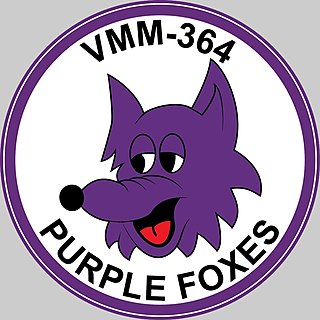
Marine Medium Tiltrotor Squadron 364 (VMM-364) is a United States Marine Corps medium-lift tiltrotor squadron consisting of MV-22B Ospreys. The squadron, known as the "Purple Foxes", is based at Marine Corps Air Station Camp Pendleton, California and falls under the command of Marine Aircraft Group 39 (MAG-39) and the 3rd Marine Aircraft Wing.

Marine Air Support Squadron 2 (MASS-2), is a United States Marine Corps aviation command and control unit that provides the Direct Air Support Center (DASC) for the III Marine Expeditionary Force. It is the oldest and most decorated aviation command and control unit in the Marine Corps.

Marine Air Support Squadron 1 (MASS-1) is a United States Marine Corps aviation command and control unit that provides the Direct Air Support Center to coordinate close air support for the II Marine Expeditionary Force. Callsign "Chieftain," the squadron is based out of Marine Corps Air Station Cherry Point, North Carolina, and falls under the command of Marine Air Control Group 28 and the 2nd Marine Aircraft Wing.

Marine Air Support Squadron 6 (MASS-6), is a reserve United States Marine Corps aviation command and control unit that provides the Direct Air Support Center (DASC) for the Marine Forces Reserve. Their headquarters is in Westover Air Reserve Base, Massachusetts and their Detachment Alpha is located at Marine Corps Air Station Miramar, California

Marine Air Control Group 28 (MACG-28) is a United States Marine Corps aviation command and control unit based at Marine Corps Air Station Cherry Point that is currently composed of four command and control squadrons and a low altitude air defense battalion that provide the 2nd Marine Aircraft Wing with airspace coordination, air control, immediate air support, fires integration, air traffic control (ATC), radar surveillance, aviation combat element (ACE) communications support, and an integrated ACE command post in support of the II Marine Expeditionary Force.

The 15th Marine Expeditionary Unit is one of seven such units currently in existence in the United States Marine Corps. The Marine Expeditionary Unit (MEU) is a Marine Air Ground Task Force (MAGTF) with a strength of about 2,200 personnel. The MEU consists of a command element, a reinforced infantry battalion, a composite helicopter squadron and a combat logistics battalion. The 15th MEU is currently based out of Marine Corps Base Camp Pendleton, California.

Marine Aviation Logistics Squadron 39 (MALS-39) is an aviation logistics support unit of the United States Marine Corps. Once known as the "Magicians," they are now known as the "Hellhounds", and they fall under the command of Marine Aircraft Group 39 (MAG-39) and the 3rd Marine Aircraft Wing and are currently based at Marine Corps Air Station Camp Pendleton, California.
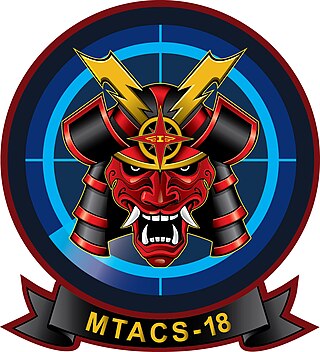
Marine Tactical Air Command Squadron 18 (MTACS-18) was a United States Marine Corps aviation command and control unit based at Marine Corps Air Station Futenma. The squadron provided the 1st Marine Aircraft Wings tactical headquarters and command post while deployed. MTACS-18 fell under the command of Marine Air Control Group 18 (MACG-18) and 1st MAW. The squadron was decommissioned on 9 June 2021 as part of the service's Force Design 2030. Responsibility for establishing 1st MAW's TACC now resides with the MACG-18 headquarters.

The United States Marine Corps is organized within the Department of the Navy, which is led by the Secretary of the Navy (SECNAV). The most senior Marine commissioned officer is the Commandant of the Marine Corps, responsible for organizing, recruiting, training, and equipping the Marine Corps so that it is ready for operation under the command of the unified combatant commanders. The Marine Corps is organized into four principal subdivisions: Headquarters Marine Corps, the Operating Forces, the Supporting Establishment, and the Marine Forces Reserve.

Operation Niagara was a U.S. Seventh Air Force close air support campaign carried out from January through March 1968, during the Vietnam War. Its purpose was to serve as an aerial umbrella for the defense of the U.S. Marine Corps Khe Sanh Combat Base on the Khe Sanh Plateau, in western Quang Tri Province of the Republic of Vietnam. The base was under siege by an estimated three-divisional force of the People's Army of Vietnam (PAVN).

Surveillance, Reconnaissance, Intelligence Groups (SRIG) were Marine Corps Intelligence, reconnaissance, and communications units of the United States Marine Corps from 1988 to 1997. The SRIG command structure combined units of Radio Battalion, ANGLICO, Force Reconnaissance, remotely piloted aircraft, counterintelligence, and other intelligence elements of the Marine Air-Ground Task Force.
Quảng Trị Combat Base is a former United States Marine Corps, United States Army and Army of the Republic of Vietnam (ARVN) base northwest of Quảng Trị in central Vietnam.

Marine Air Support Squadron 5 (MASS-5) was a United States Marine Corps aviation command and control unit that provided the Direct Air Support Center (DASC) capability for the I Marine Expeditionary Force from 1966 through 1969. MASS-5 was headquartered at Marine Corps Air Station El Toro, California, and was part of Marine Air Control Group 38 and the 3rd Marine Aircraft Wing.

Marine Air Support Squadron 4 (MASS-4) was a reserve United States Marine Corps aviation command and control unit that provided the Direct Air Support Center (DASC) capability from 1962 through the early 1990s. MASS-4 was headquartered at Naval Air Station Los Alamitos, California, and was part of Marine Air Control Group 48 (MACG-48) and the 4th Marine Aircraft Wing.

The General Electric AN/TPQ-1O Course Directing Central was a light-weight, two-unit, helicopter transportable, ground based bombing system developed for use by the United States Marine Corps to provide highly accurate, day/night all weather close air support. This self-contained system was designed to guide an aircraft, equipped with the proper control equipment, to a release point for accurate all-weather delivery of ordnance and supplies to a preselected target. The AN/TPQ-10 and its operators were known as an ‘’Air Support Radar Team’’ (ASRT) and were employed by the Marine Air Support Squadrons within the Aviation Combat Element.
The Marine Air Command and Control System (MACCS) is the aviation command and control agencies of the United States Marine Corps that provide the Aviation Combat Element (ACE) commander with the means to monitor, supervise, and influence aviation operations in support of the Marine Air-Ground Task Force. The command and control agencies of the MACCS are provided by the squadrons and battalions of the Marine Air Control Groups that are present within each Marine Air Wing. The capabilities resident within the MACCS allow the MAGTF commander to safely conduct aviation operations, facilitate timely maneuver and prosecution of fires and ultimately retain full control of their entire area of operations. MACCS agencies are also responsible for coordinating Marine Corps aviation operations with joint, multinational and civil aviation.



